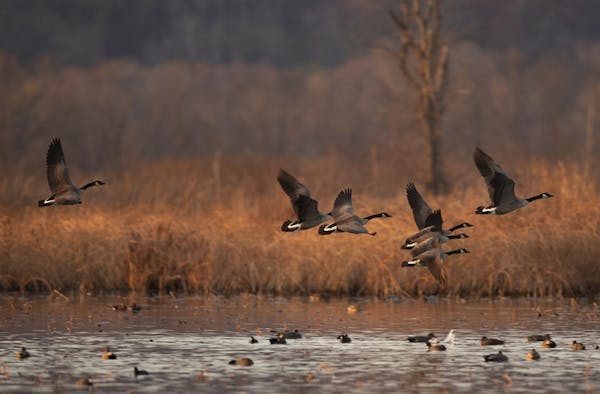TWO HARBORS, Minn. – Trolling is cheating.
When it comes to catching lake trout in the most pristine of the Great Lakes, that's the code of a band of North Shore anglers who take great pleasure in jigging vertically in water deep enough to cover lesser skyscrapers.
"I cheat sometimes, but it takes more skill to jig," said Tim Sonday, an operation technician at Northshore Mining in Silver Bay.
He's been chasing Lake Superior's apex predators for more than 30 years, often from the same type of 16-foot aluminum tiller boat commonly rented at the smallest of Minnesota's inland family resorts. The only special rigging he uses is an oversized, hand-cranked anchor that drops as deep as 200 feet. He also relies heavily on an electronic screen to find fish and track GPS location.
"We caught six in a half-hour the other day," Sonday said last week. "You feel the fish and you have to react quickly. They fought us all the way up."
Loren Slette, co-owner of a building and design company in Duluth, is unfamiliar with Sonday but just as dedicated to lake trout jigging. He fishes on Superior year-round, accompanied by his pal Bruce Sederberg, the owner of a Duluth fishnet business.
"We get out there as long as the lake is open," Slette said. "January, February… sometimes that's been the best jigging we've had."
But the most reliable time to jig for lake trout on the big sea is almost here. Slette said the fish typically bite most aggressively during their pre-spawning period of late September and early October. That's when the water cools and the fish congregate around underwater humps. And for more than a few years now, surveys have indicated high catch rates.
The trout season on Lake Superior closes Oct. 6 to safeguard spawning. This year, it starts back up on Dec. 1.
"We never miss an opener!" Sederberg said.
Bumps and saddles
Early one June morning, Slette maneuvered his open-air, 18-foot Lund Alaskan away from the long public dock in Two Harbors. With his hand on the tiller, he puttered out beyond the stone breakwall, then accelerated north in bright sunshine to a series of fishing spots marked on his locator for past success. We were about a mile from land in calm water, hovering over spots as deep as 170 feet. Each one featured a special contour — a bump or a saddle — in Superior's clay bottom.
Slette felt heaviness on his line and forcefully jerked his forearm upward to set the hook. The stout fishing rod arced and Slette moved his right hand forward, just past the rod's handle. He was gaining leverage for a five-minute fight that ended with the fish lying flat on the bottom of an ice cooler. It was a 6-pounder, at least.
He and Sederberg once tipped their heavyweight hair jigs and pot belly jigs with pieces of smelt or herring. Now they favor heavyweight jigs festooned with soft, colorful plastic. Less mess, they said, and still a lot of action.
The state bag limit for Lake Superior's "lean" lake trout is three of any size. "Lean" differentiates the lake's table-fare trout from its fatty, deeper-dwelling cousin — the siscowet.
Cory Goldsworthy, the North Shore fisheries supervisor for the Department of Natural Resources, said the state doesn't want to impose a size limit because a fair number of lake trout die of hooking mortality when the surface water temperature is over 50 degrees. Barotrauma, or injury caused by reeling some fish too quickly from deep water, is not as much of a concern for the species.
"We would much rather see folks catch and keep three than potentially kill 40 percent of the lake trout they throw back," Goldsworthy said.
Smoke 'em if you got 'em
Friends and family of Sonday crave his smoked lake trout, a specialty he prepares with a brown-sugar glaze. But his appetite for jigging comes first.
"You can catch them trolling, but jigging is kind of like normal fishing," he said.
Sonday believes in the power of smelt. When the hot dog-sized forage fish are schooling in lake trout territory, the bigger fish feed "like they're at a Las Vegas buffet," he said. Hence, the ever-presence of a cutting board on his boat to prepare heads and bellies for jigs.
Sonday has taken a liking to heavy jigs covered in tubes of soft plastic. But he still tips them with a piece of smelt and buries an extra treble hook, or "stinger," into the meat.
Shallower water around Isle Royale is a popular place to jig for lake trout, but Sonday said there's a special community of anglers who dwell in deeper water — from 135 to nearly 200 feet. It's the thrill of feeling a heavy fish so far away, jacking it to set the hook and mastering the retrieve.
"Sometimes with walleyes you have to wait and let them take it," Sonday said. "Not with these."
Sonday was marking fish on his electronics at a depth of 165 feet when a 22-inch lake trout made a long-distance call to Scott Ward of Inver Grove Heights. On his first Lake Superior jigging outing, Ward answered the yank with a proper jolt. He had jammed the stinger into the side of the trout's mouth.
The fish was still 20 or 25 feet below the surface when Superior's clear water allowed for a glimpse. It had lost some of its fight and was visible in flashes of silver and white as it continued to try to swim away.
Catching one in three hours was enough to make us want to go back. We shared the water with taconite freighters, but the immensity of Lake Superior no longer seemed intimidating. If only you lived on the North Shore to take advantage of those hard-to-predict windows of calm.

Taylor Pendrith rolls into second-round lead at 3M Open
Coughlin holds into CPKC Women's Open lead; Canadian star Henderson derailed by closing bogeys


